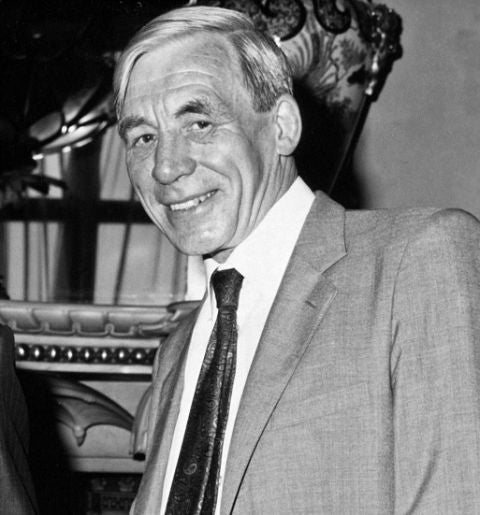Kenneth Johnson: Inspirational lecturer and researcher who wrote the definitive text on contact mechanics
He joined the Hallé Choir, and toured the country in 1951 as part of the Festival of Britain

Your support helps us to tell the story
From reproductive rights to climate change to Big Tech, The Independent is on the ground when the story is developing. Whether it's investigating the financials of Elon Musk's pro-Trump PAC or producing our latest documentary, 'The A Word', which shines a light on the American women fighting for reproductive rights, we know how important it is to parse out the facts from the messaging.
At such a critical moment in US history, we need reporters on the ground. Your donation allows us to keep sending journalists to speak to both sides of the story.
The Independent is trusted by Americans across the entire political spectrum. And unlike many other quality news outlets, we choose not to lock Americans out of our reporting and analysis with paywalls. We believe quality journalism should be available to everyone, paid for by those who can afford it.
Your support makes all the difference.Kenneth Johnson was a distinguished academic engineer, and author of the principal text in contact mechanics, his specialist area. As a long-serving Fellow of Jesus College Cambridge and member of Cambridge University engineering department, he is remembered by staff and former students as an inspirational lecturer, an outstanding researcher and a supportive colleague.
Born in 1924, he was raised in Barrow-in-Furness, famed for its iron, steel and shipbuilding, and attended Barrow Grammar School, where his father spent nearly all his teaching career. Ken set out on an academic trajectory aimed for Cambridge, but also led an active life of rugby, athletics, scouting and, later, fell-walking and climbing on the west Cumbrian fells. Later in his life, he often returned to Cumbria, buying a cottage in Ravenglass which became a family base for exploration of the western Lakes.
In 1941, when he was in the sixth form, Barrow – an obvious strategic target – was bombed. In normal circumstances he would have stayed at school for a Cambridge scholarship year, but there was a pressing need for technically qualified staff, and he became a “Snowflake” – interviewed by CP Snow, then director of technical personnel at the Ministry of Labour, he was given a state scholarship on an accelerated course to read mechanical engineering at Manchester. After two years and three months, he graduated with a First and was sent to Rotol in the Gloucester area, a company making aircraft propellers. He later recalled that the introduction of a five-bladed propeller for the later versions of the Spitfire helped him to equitably divide the pie when his immediate family numbered five.
In 1949 he ventured back to Manchester as an assistant lecturer in engineering, having by now met his wife-to-be, Dorothy Watkins, during wholesome outdoor pursuits such as walking, cycling and youth hostelling.
His work at Manchester included a part-time PhD in which he developed his ideas of vibration damping in propeller assemblies by investigating the effects of micro-slip at the interface of joints. Thus began his devotion to the study of contact mechanics.
His interest in the outdoors and scouting also flourished, as did choral singing. He joined the Hallé Choir, and during the Festival of Britain in 1951, he toured the country under Barbirolli, singing at the reopening of the bomb-damaged Free Trade Hall in Manchester.
In 1954, Ken and Dorothy married and moved to Cambridge, where he had been appointed a demonstrator in engineering. He remained at Cambridge for the rest of his career – and was elected a Fellow of Jesus College in 1957.
His work achieved lasting esteem among his peers, not through quantity – he published relatively few papers by today’s standards – but through research of the highest quality. Not for Johnson the academic buzzwords of today, huge research teams, mega-grants, spin-offs ,publicity or self-promotion. He espoused the nobler characteristics of scholarship: integrity, deep thought and the highest of intellectual standards. He also took teaching very seriously.
He won many academic awards and was elected a Fellow of the Royal Society in 1982 and of the Royal Academy of Engineering in 1987. He was awarded the Tribology Gold Medal in 1985 (tribology is the study of friction, lubrication and wear), and received the 2006 Timoshenko Medal of the American Society of Mechanical Engineers. His acceptance speech, which can readily be found on the internet, affords a shining example of his clever, dry wit and self-deprecating humour. He spent two periods of sabbatical leave in the US. His magnum opus, Contact Mechanics, was published in 1985.
Of the many major accolades Ken received, the 2003 Queens’ Medal of the Royal Society gave him the most pleasure. The citation could not be bettered for accurate succinctness: “His work is characterised by elegant experiments, skilful analysis and insightful explanation of observed phenomena.” Around this time he was invited to a Downing Street reception and was rendered nearly speechless when Margaret Thatcher prefaced a sentence with the words, “We scientists…”
Many younger members of Cambridge University engineering department were inclined to view Ken at a respectful distance. His rather lined, lugubrious and lived-in face made him seem very senior. But many were to discover the warmth, the charm and the humour behind what appeared to be a severe façade.
Ken was a man of great modesty and humility. He was more than fulfilled in his Cambridge life and did not seek further preferment. Typically, on hearing the news of some prestigious award that was offered to him, he would say with his characteristic modesty, “I wonder if they have the right Johnson?” or “There are many much better than me.”
Kenneth Langstreth Johnson, engineer: born 19 March 1925; married 1954 Dorothy Watkins (two daughters, one son); died 21 September 2015.
Join our commenting forum
Join thought-provoking conversations, follow other Independent readers and see their replies
Comments